


Fifty Days of Sand and Camels
In 2012 Bill and I walked 900 miles with a twelve member Berber family. They led 26 camels and we led our four camels all loaded with supplies and water. Drought and dropping water tables are a modern-day concern in an expanding desert that is a hostile place of little rain. The lack of water for the family's herds had forced them to sell most of their animals. Now they planned to travel to Mali to join the rest of their family who, although experiencing their own water crisis, were able to keep their herds of sheep, goats and camels intact. The family elders had decided that after joining to form one large unit they would then travel to a more reliable water supply with ample animal grazing. They believed that improved living conditions would give them and their animals an easier life and would allow them to raise their children in true nomad style. Our course was an ancient camel trade route first documented in the eleventh century. Salt, gold, dates and slaves were transported from Timbuktu in Mali, then north across the desert to the northern coast of Morocco to be sold and loaded onto ships for transport to Europe and America. We flew to Casablanca Morocco, then on to Marrakesh, a large bustling city of over one million people. This was our third visit to the city and although we always looked forward to exploring the markets, watching the snake charmers and colorful people, this time we hurried to meet our friend Ashar who had arranged for us to travel with the Berber family.
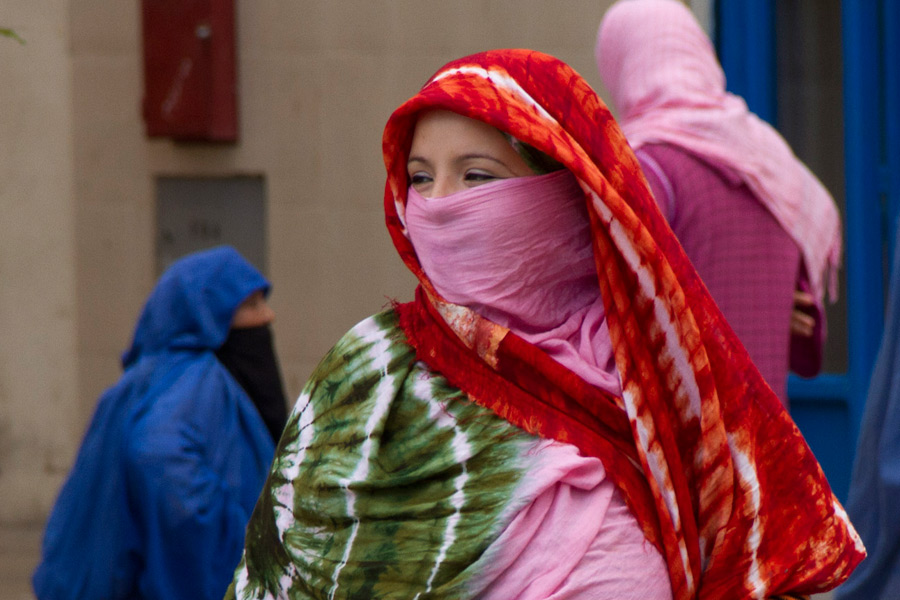
Traveling the main road leading out of Marrakesh toward the Sahara, we drove a rented Toyota through the mountains to the ancient walled city of Taroudant. Similar to Marrakesh in layout, the city is often called the "Grandmother of Marrakesh." Today it has the feel of a small, fortified market town on a caravan route. The city is known for its local crafts of jewelry and carpets. Next, we drove through some of the most dramatic scenery in all of Morocco to Tata, a village of around fifteen thousand people. We wound our way through the Anti Atlas Mountains of layered, rose-colored rock bands, streaked in shades of brown and yellow. Our next stop was at Foum Zguid, a small city of just over nine thousand close to the Algerian border and located on the western edge of the Sahara. However due to political tension over border disputes and smuggling between Morocco and Algeria the border was closed and it was illegal to cross. The Tata police examined our passports before we were allowed to continue into the Moroccan Sahara.
. . . . . . . . . . . . . . . . . . . . . . . . . . . . . . . . . . . . . . . . . . . . . .

We left the city and two dusty, roadless hours later we arrived at the camp of the waiting Berber family. We were introduced to Anwar, the family leader and patriarch. A regal and gracious man, he introduced us to his family. After the traditional drawn out introductions and three cups of sweet mint tea we unloaded our gear from the Toyota and bid goodbye to Ashar. The family had rarely mixed with westerners and with the exception of Anwar they regarded us with some wariness. They inspected our belongings and looked suspiciously at the cameras. The women were especially shy. However over a dinner of a meat and vegetable stew and more tea everyone relaxed and it was clear that we had made new friends. Anwar had attended school in his youth and even now in his fifties he retained an excellent grasp of English. This along with our French and some Arabic our communication went well. We were fortunate that these Berbers, the masters of survival in this unyielding land, welcomed Bill and I into the routine of their daily life.
. . . . . . . . . . . . . . . . . . . . . . . . . . . . . . . . . . . . . . . . . . . . . .
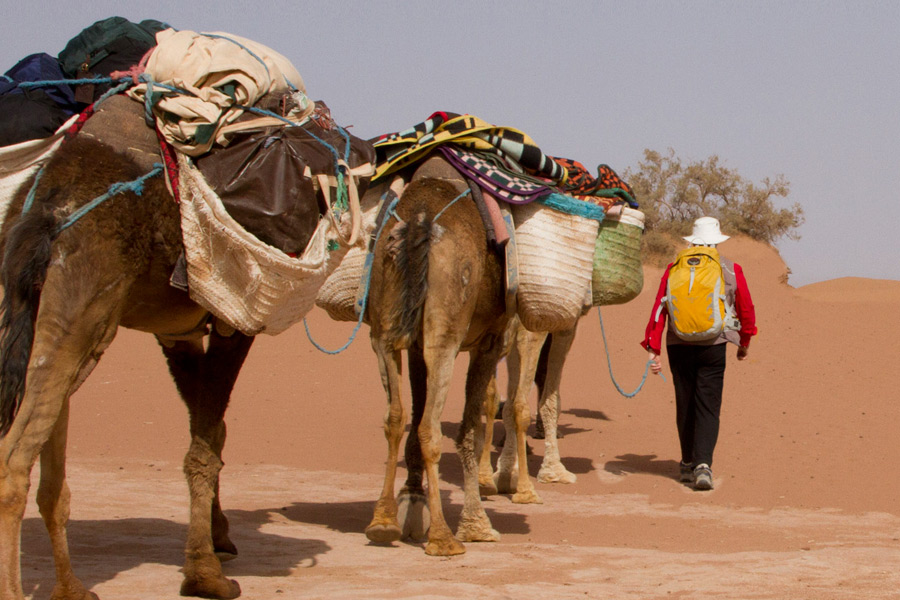
The next day was spent loading the family's 26 camels with all their household belongings, food and water for the journey ahead. Then our four camels were loaded with our equipment and supplies and by nightfall everyone and the camels were ready to leave. Bill and I, leading our camels, dropped in behind Anwar who led the way across the sandy waste toward the Algerian border. At midnight the remote, rarely traveled section of the Moroccan-Algerian border lay a quarter mile away bathed in the shadowy light of a quarter moon. We watched a Moroccan border patrol drive by in a noisy jeep and disappear over a low hill in the wide-open desert.
. . . . . . . . . . . . . . . . . . . . . . . . . . . . . . . . . . . . . . . . . . . . . .
For thousands of years the Berber peoples of North Africa have clung to their distinct identity and many still follow a nomad's lifestyle. This nomadic family regularly traveled with their herds across the desert plains and oases, settling close to reliable water and food supplies. In the past, country borders had not been a problem. The entire desert was their home. In the modern day era of border disputes and political unrest even nomadic Berbers must obtain permission to cross national boundaries. However the volatile political situation makes it impossible to gain the required consent. Many families solve the problem in their traditional way. They simply ignore those invisible lines that divide countries just as they had for past centuries. Anwar silently raised his hand to signal that we should all travel single file across the border with no more talking to avoid detection by guards. Bill and I fell in line hardly daring to breath as we picked our way through the baseball-sized rocks across the sparsely marked frontier. The only sound was the soft, almost silent padding of our camel's feet and sixteen human, carefully placed silent footsteps. Soon we were safely and undetected across our first border and headed southeast on our way to walk from Morocco across Algeria, Mauritania and finally northern Mali to meet the awaiting extended family members and their flocks.
. . . . . . . . . . . . . . . . . . . . . . . . . . . . . . . . . . . . . . . . . . . . . .
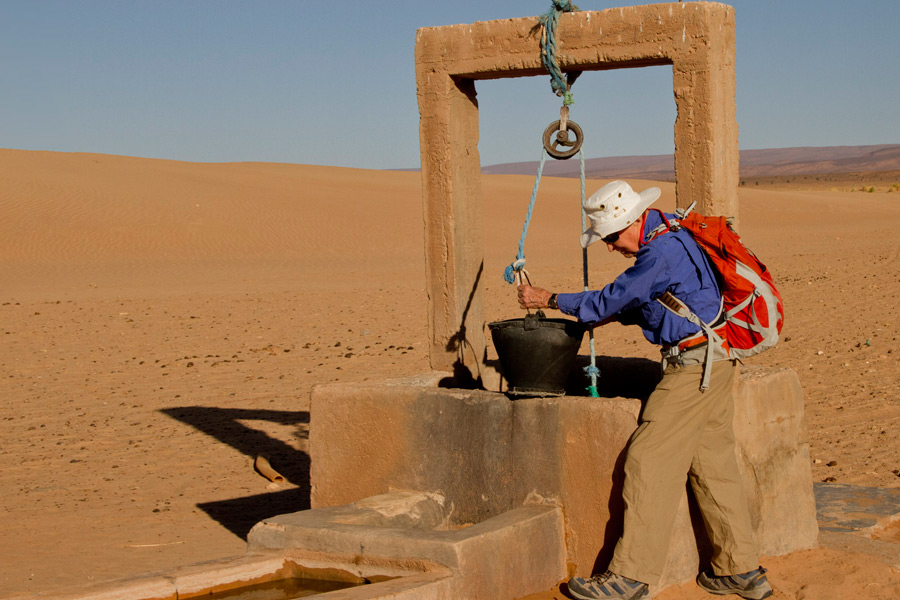
We crossed vast plains that stretched ahead in naked folds and in places the baked earth was nearly sterilized by extreme drought that had long ago chased all living creatures to more friendly environments. At times we were confronted by horizons that seemed impossibly far. Some days were spent fighting through a roaring wind strong enough to send us staggering to stay on our feet. Blowing sand stung and blasted any exposed skin and obliterated the way ahead. Locating the water wells was crucial to our survival. To the Berbers navigation was a simple affair. They had no need for our GPS and maps. All they needed were the stars and a description of each well's location that had been handed down through generations of nomadic travelers. Some wells showed clearly above ground while others were merely an obscure hole in the earth covered with a flat lid.
. . . . . . . . . . . . . . . . . . . . . . . . . . . . . . . . . . . . . . . . . . . . . .
At the end of the first week we breached a low rise among sand dunes and looked ahead to a moonscape of mile after mile of scorched earth, rocks, and flat barren earth that looked as though all life had fled the engulfing furnace and raking powerful winds. A few lonesome wisps of dried grass showed above the parched earth. Camel fodder that night would have to be hay carried by the camels. Water would come later when we arrived at a well three days away. Each day, just before dawn Anwar called all the men to morning prayers. To conserve precious water they used sand to wash. Then kneeling on their prayer mats they faced east and prayed to Allah. In the background the women silently tended a fire to heat water for the obligatory custom of tea drinking which we had discovered from several previous Sahara journeys to be essential to desert existence. Only after at least three small glasses of sweetened tea were consumed could the camels be loaded and the day's journey started. It seemed that tea was the desert lubrication that provided the ambition to face the day's trek which began in the predawn soft light that quickly gave way to a rising sun that soon engulfed all living and non living things in shimmering heat that bore into every human core. Nights, although often 40 degrees cooler than noon temperatures, were a welcome relief to mind and body.
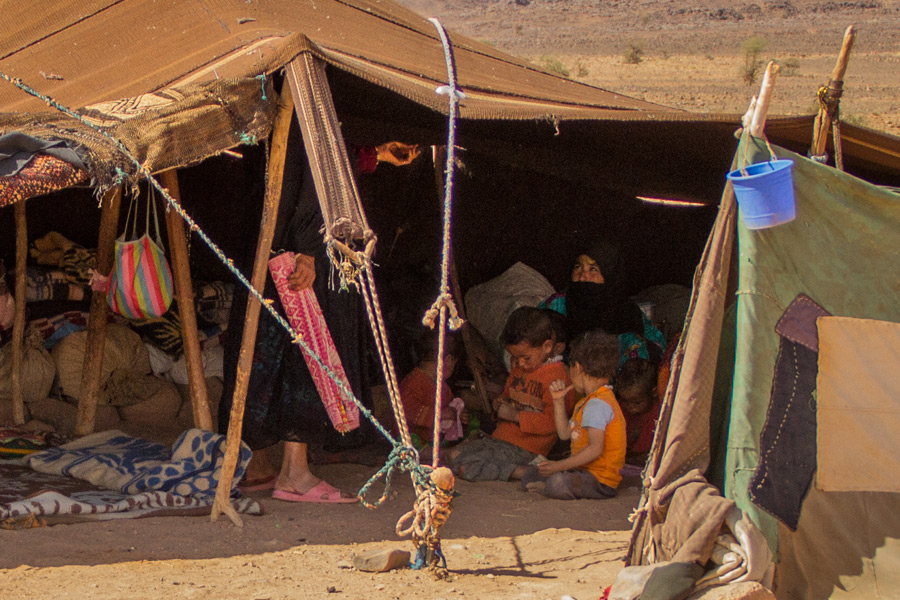
. . . . . . . . . . . . . . . . . . . . . . . . . . . . . . . . . . . . . . . . . . . . . .
For generations Berbers had travelled as we now travelled across this ancient land. It was a journey into another world, although remarkable in its simplicity, we were well aware that a single mistake such as a missed well could spell disaster. We plodded on at a steady pace with regular breaks for tea and Islamic prayers and to allow the camels to grab whatever fodder was available. Some days we traveled through sand dunes where each step in the soft sand was an ordeal. The rocky plains were hard on feet and ankles. In places we looked ahead to mile after mile of flat land, cracked and naked, devoid of all plant life. A single moderately sized rock would have looked huge in proportion to the surrounding billiard table flatness. Each day as darkness settled we made camp. Our shelter was a simple floorless tent made of brown woven goat and camel hair fabric about twelve feet long and six feet wide with sides that could be dropped in strong winds to keep at least some of the sand at bay. The entire structure was propped up with wooden poles. Firewood gathered during the day's travel made the evening fire on which the women cooked a soup of vegetables and dried meat. Bread cooked in the hot embers of a shallow hole and covered with hot sand made a filling meal followed of course by several cups of sweet tea. Dates, the energy food of the desert, were always available for a quick snack during the day. Occasionally we met others traveling with camels and livestock to a far off oasis. Conversation never began before the long drawn out greeting ritual took place in which each side echoes the other in enquiries about health, livestock and family. Day after day we walked onward always on the watch for desert bandits who might steal camels and belongings. Our gear and clothing were severely tested in the extreme environment. We kept our camera lenses in plastic bags but even then the sand forced its way inside. Finally, on the horizon, we spied the long sought camp of the extended family members, some of whom came to meet us with hoops of joy at once more joining together as one large family. The next day was spent breaking camp and sorting the new addition's belongings. After their eight camels were loaded we all turned north, our ranks swelled by six more people, their eight camels and their animals. After crossing more sand dunes, flat open plains and navigating through a rocky pass we entered the shallow valley of a small oasis with a good well full of salt free water and sufficient fodder for the herds. Confident that the area was suitable, the family erected their tents and set up home.
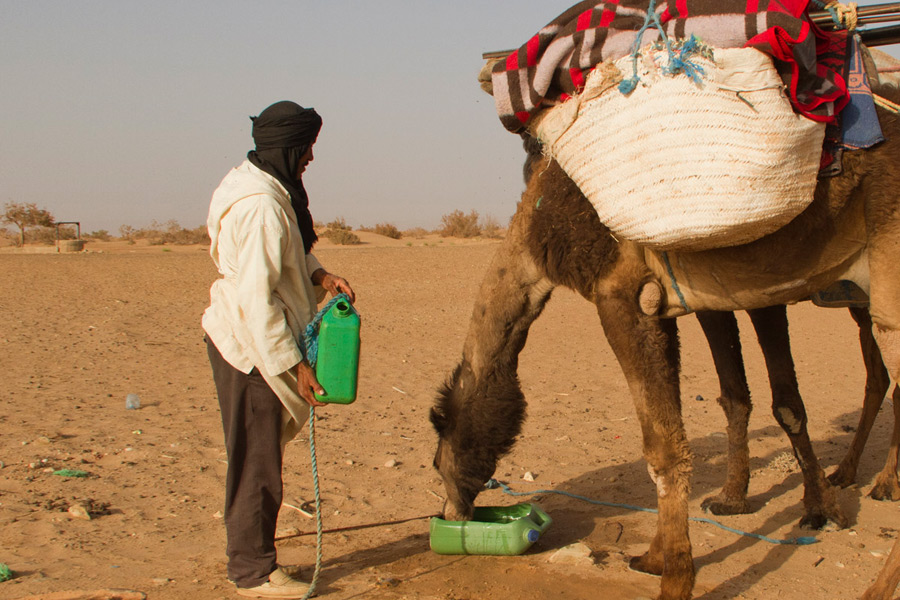
. . . . . . . . . . . . . . . . . . . . . . . . . . . . . . . . . . . . . . . . . . . . . .
However water would continue to be an ongoing problem. If this well would run dry and animal fodder disappears, then the entire family would once again move to another location. Although nomads are used to following the water and fodder supply, the problem of finding enough salt free water to sustain themselves and their herds is unrelenting due to the effects of global warming and the continued expansion of hot dry deserts worldwide. After bidding farewell to our friends, Bill and I continued across the desert to return to Morocco accompanied by a family son, Abdul Ali. Our 50-day journey was over. In spite of the hardships of extreme desert travel on foot through one of the most arduous places on earth we were sorry to say goodbye to our four faithful camels. However as pre arranged, they would be permanently retired to a good family and live a life of luxury as a reward for their faithfulness.
. . . . . . . . . . . . . . . . . . . . . . . . . . . . . . . . . . . . . . . . . . . . . .
Over the last several years Bill and I have journeyed on foot across various regions of the Sahara including one long, grueling expedition from Morocco to the Nile River. Each journey provides new experiences and increases our desire to continue exploring this great desert and enjoy the company of its many cultures. It was a privilege to be allowed to join this family, experience their daily life and make new friends. They taught us a lot and we are better for the experience and for knowing them.
Back to Journals Index
